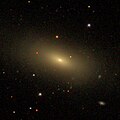| NGC 7600 | |
|---|---|
 NGC 7600 (legacy surveys) | |
| Observation data (J2000 epoch) | |
| Constellation | Aquarius |
| Right ascension | 23h 18m 53.8s [1] |
| Declination | −07° 34′ 50″ [1] |
| Redshift | 0.011618 [1] |
| Apparent magnitude (V) | 12.95 [1] |
| Characteristics | |
| Type | S0 [1] |
| Apparent size (V) | 2.5' × 1.1' [1] |
| Other designations | |
| MCG -01-59-019, 2MASX J23185385-0734495, 6dF J2318539-073450, PGC 71029 [1] | |
NGC 7600 is a galaxy about 160 million light-years from Earth, located in the constellation Aquarius. It is classified as a lenticular galaxy, or, more formally, an S0 galaxy. [2] [3] [4]
